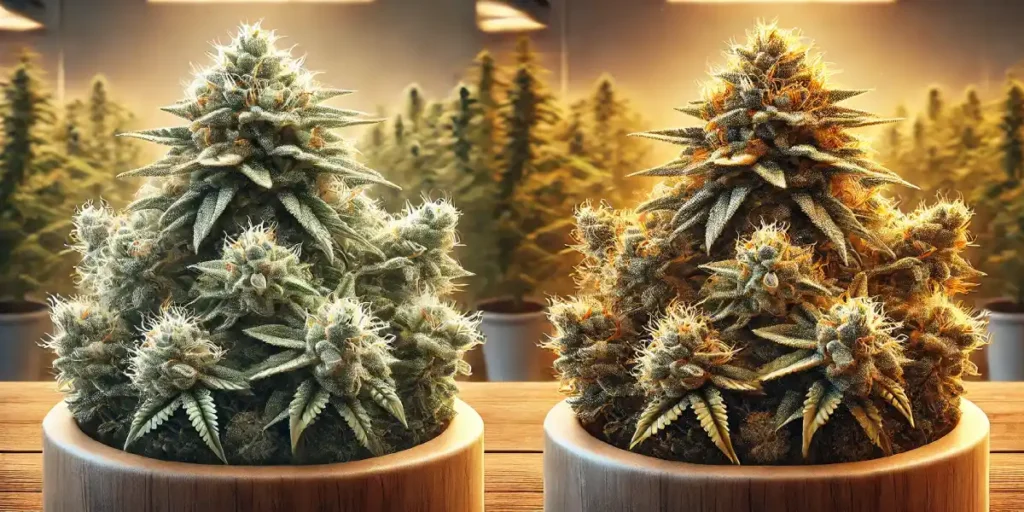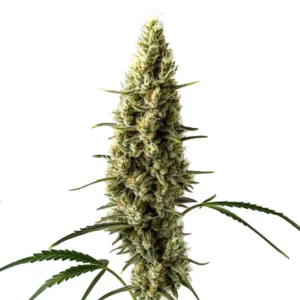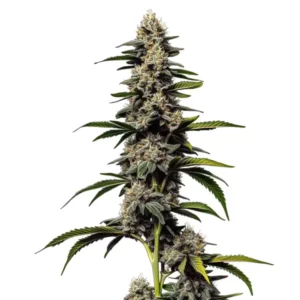Under Ripe Buds: What They Are and Why They Matter
Cultivating cannabis is an art and a science. One of the most crucial aspects is knowing when to harvest your plants. Harvesting too early, especially when buds are early harvested, can lead to under ripe buds, which can be a significant disappointment after months of careful cultivation. These buds lack the potency, flavor, and overall quality that fully matured buds possess. On the other hand, harvesting too late can result in over ripe buds, which may also affect the desired potency and flavor. This comprehensive guide will help you understand what under ripe buds are, why they matter, and how to avoid them, as well as how to prevent over ripe buds, to ensure a perfect harvest every time.
What Are Under Ripe Buds?
This buds are cannabis flowers that have not reached their full maturity before being harvested. These buds often appear smaller, less dense, and less potent compared to their fully matured counterparts. The trichomes, or resin glands, on under ripe buds are usually clear rather than the cloudy or amber color that indicates peak ripeness. This immaturity affects not only the visual appeal but also the chemical composition, resulting in lower THC levels and less developed terpene profiles.
Why Under Ripe Buds Matter
The impact of this buds extends beyond just appearance. Harvesting cannabis at the right time is essential for maximizing the plant’s potential. Under ripe buds can lead to:
- Reduced Potency: THC and other cannabinoids are less concentrated in this buds, leading to a weaker product.
- Inferior Flavor and Aroma: The terpene profile of under ripe buds is underdeveloped, resulting in a less flavorful and aromatic experience.
- Wasted Effort: Months of care and cultivation can feel wasted if the final product does not meet quality expectations.
Promos & Deals
Signs of Under Ripe Buds
Recognizing the signs of under ripe buds is the first step in ensuring you avoid early harvested flowers and harvest at the right time. Here are some key indicators to look for:
Visual Indicators
- Trichome Color: Clear trichomes are a clear sign of this buds. Mature buds should have cloudy or amber trichomes.
- Bud Size and Density: Under ripe buds are often smaller and less dense compared to mature buds.
- Pistil Color: The pistils, or hairs on the buds, should be turning reddish-brown. If they are still mostly white, the buds are likely under ripe.
Sensory Indicators
- Aroma: This buds have a less pronounced aroma compared to mature buds.
- Touch: Mature buds feel sticky and resinous to the touch, while under ripe buds may feel dry and less sticky.

Causes of Under Ripe Buds
Identifying the causes of under ripe buds can help you take preventive measures. Several factors may contribute to this issue:
Environmental Factors
- Temperature and Humidity: Inconsistent temperature and humidity levels can slow down the maturation process.
- Light Exposure: Insufficient light can prevent buds from reaching full maturity.
Nutrient Deficiencies
- Lack of Nutrients: Inadequate nutrients during the flowering stage can result in underdeveloped buds.
- pH Imbalance: Incorrect pH levels in the soil or water can hinder nutrient uptake, affecting bud development.
Harvest Timing
- Early Harvest: Buds that are early harvested are the most common cause of under ripe buds. Patience is key to ensuring buds reach their full potential.
How to Prevent Under Ripe Buds
Preventing this buds involves careful monitoring and precise control of the growing environment. Here are some strategies to help you avoid this issue:
Monitor Trichome Development
Regularly inspect the trichomes on your buds to determine the optimal harvest time. Use a magnifying glass or digital microscope to get a clear view of the trichomes’ color and development.
Maintain Optimal Growing Conditions
- Temperature and Humidity: Keep temperatures between 70-85°F (21-29°C) during the day and slightly cooler at night. Maintain humidity levels between 40-60% during the flowering stage.
- Light Exposure: Ensure your plants receive adequate light during the flowering stage. Consider using high-quality grow lights if growing indoors.
Proper Nutrient Management
- Balanced Nutrition: Provide balanced nutrients throughout the growing cycle, especially during the flowering stage.
- pH Monitoring: Regularly check and adjust the pH levels of your soil or hydroponic solution to ensure optimal nutrient uptake.
The Best Time to Harvest: Ensuring Fully Mature Buds
Knowing when to harvest is crucial for avoiding under ripe buds. Here’s how to determine the best time to harvest your cannabis plants:
Trichome Inspection
- Clear Trichomes: Indicates that buds are still developing and not ready for harvest.
- Cloudy Trichomes: Signifies peak potency, and the optimal time to harvest for a balanced effect.
- Amber Trichomes: Suggests a more sedative effect, indicating that buds are fully mature and nearing over ripeness.
Pistil Color
- White Pistils: Indicate that buds are still maturing.
- Reddish-Brown Pistils: Signifies that buds are mature and ready for harvest.

Common Mistakes about Under Ripe Buds and How to Avoid Them
Avoiding common mistakes can help you achieve the perfect harvest and avoid under ripe buds. Here are some pitfalls to watch out for and how to prevent them:
Harvesting Too Early
Impatience is a common mistake among new growers. Harvesting too early results in underdeveloped buds. Always wait for the trichomes to turn cloudy or amber before harvesting.
Inconsistent Growing Conditions
Fluctuations in temperature, humidity, and light exposure can hinder bud development. Maintain stable growing conditions throughout the flowering stage.
Neglecting Nutrient Needs
Failing to provide adequate nutrients can stunt bud growth. Follow a nutrient schedule that supports healthy bud development, and adjust as necessary based on the plant’s needs.
How to Improve Your Cannabis Harvest: Strategies for Optimal Bud Development
Improving your cannabis harvest involves more than just avoiding under ripe buds. Here are some strategies to help you achieve the best possible results:
Regular Monitoring
Regularly check your plants for signs of maturity, pest infestations, and nutrient deficiencies. Early detection and intervention can prevent problems from affecting your harvest.
Pruning and Training
- Pruning: Remove lower leaves and branches to direct the plant’s energy towards bud development.
- Training: Techniques like topping, low-stress training (LST), and screen of green (SCROG) can help maximize bud production and improve light penetration.
Proper Drying and Curing
After harvesting, proper drying and curing are essential for preserving the quality of your buds.
- Drying: Hang your buds upside down in a dark, well-ventilated room for 7-10 days.
- Curing: Place the dried buds in airtight glass jars, opening them daily for the first week to release moisture, then store in a cool, dark place for 2-3 weeks to develop flavor and potency.
Advanced Techniques for Mastering Cannabis Cultivation
For experienced growers looking to take their cultivation skills to the next level, advanced techniques can help optimize bud development and avoid under ripe buds.
Hydroponics
Hydroponic systems allow for precise control over nutrient delivery and environmental conditions, promoting faster growth and higher yields.
CO2 Enrichment
Increasing CO2 levels in your grow room can enhance photosynthesis and boost bud development. Use a CO2 generator or tank to maintain levels between 1000-1500 ppm.
Genetic Selection
Choose strains known for their stability and resistance to environmental stress. Breeding programs can also develop strains with desirable traits, such as faster maturation and higher potency.
How spray Terpenes Influence Bud Development
Spray Terpenes play a crucial role in the flavor, aroma, and effects of cannabis. How terpenes develop can help you optimize bud quality and avoid under ripe buds.
Key spray Terpenes to Monitor
- Myrcene: Adds an earthy, musky aroma and promotes relaxation.
- Limonene: Provides a citrusy scent and uplifting effects.
- Pinene: Contributes a pine-like aroma and enhances focus.
Enhancing Terpene Production
- Light Spectrum: Use full-spectrum grow lights to support terpene production.
- Nutrient Additives: Consider using supplements designed to boost terpene levels.
Expert Tips for Perfect Harvest Timing and avoid Under Ripe Buds
Harvest timing is crucial for avoiding under ripe buds and achieving the best possible results. Here are some expert tips to help you master the art of harvest timing:
Trust Your Senses
- Visual Inspection: Regularly inspect your buds for trichome color and pistil development.
- Aromatic Cues: Pay attention to changes in aroma, which can indicate maturity.
Utilize Technology
- Digital Microscopes: Invest in a digital microscope to closely monitor trichome development.
- Mobile Apps: Use mobile apps designed for cannabis cultivation to track plant growth and receive harvest reminders.
Continuous Learning
- Stay Informed: Keep up with the latest research and cultivation techniques.
- Network with Growers: Join online forums and local grower groups to share experiences and learn from others.

Under Ripe Buds: Integrating the Knowledge into Your Cultivation Routine
Implementing the strategies and knowledge discussed in this article can help you avoid under ripe buds and achieve a successful harvest. Here are some practical steps to get started:
Create a Monitoring Schedule
- Regular Inspections: Set a schedule for regular plant inspections, focusing on trichome development, pest control, and nutrient levels.
- Record Keeping: Maintain detailed records of plant growth stages, environmental data, and harvest times to identify patterns and improve future grows.
Invest in Quality Equipment
- Environmental Controls: Purchase reliable temperature and humidity control systems to maintain optimal growing conditions.
- Inspection Tools: Equip yourself with magnifying glasses, digital microscopes, and other tools for precise monitoring.
Continuous Improvement
- Evaluate and Adjust: After each harvest, evaluate what worked well and what could be improved. Adjust your growing practices accordingly.
- Stay Educated: Attend workshops, read industry publications, and network with other growers to stay informed about the latest trends and techniques.
FAQs About Under Ripe Buds
What Are Under Ripe Buds?
Under ripe buds are cannabis flowers that have not reached their full maturity before being harvested. They often appear smaller, less dense, and less potent compared to fully matured buds.
How Can I Prevent Under Ripe Buds?
Preventing this buds involves careful monitoring of trichome development, maintaining optimal growing conditions, and ensuring proper nutrient management. Regularly inspect your plants and adjust environmental factors as needed.
What Are the Signs of Under Ripe Buds?
Common signs of under ripe buds include clear trichomes, smaller and less dense buds, and white pistils. The aroma of this buds is also less pronounced compared to mature buds.
Why Are Under Ripe Buds a Problem?
Under ripe buds have reduced potency, inferior flavor and aroma, and can feel like a waste of effort after months of cultivation. They lack the fully developed cannabinoids and terpenes that contribute to a high-quality product.
How Do I Know When to Harvest My Cannabis?
The best time to harvest is when the trichomes are mostly cloudy with a few amber ones. The pistils should also be turning reddish-brown. Regularly inspect your buds using a magnifying glass or digital microscope to determine the optimal harvest time.
Can Under Ripe Buds Be Salvaged?
While you can’t fully reverse the effects of under ripeness, you can still use this for making concentrates or edibles, where the exact potency and flavor may be less critical.
What Are the Best Growing Practices to Avoid Under Ripe Buds?
Follow a nutrient schedule that supports healthy bud development, maintain consistent environmental conditions, and regularly monitor your plants for signs of maturity. Implement advanced techniques like hydroponics and CO2 enrichment for better results.
How Can I Improve My Cannabis Harvest?
Improving your cannabis harvest involves regular monitoring, proper pruning and training, and effective drying and curing processes. Use advanced techniques and quality equipment to optimize bud development.
What Are the Future Prospects for Cannabis Cultivation?
Ongoing genetic research and advanced cultivation techniques promise to enhance cannabis cultivation further, potentially leading to more refined effects and sustainable growing practices.
How Do I Integrate the Knowledge Into My Cultivation Routine?
Create a monitoring schedule, invest in quality equipment, and continuously evaluate and adjust your growing practices. Stay informed about the latest trends and techniques to achieve the best possible results.
















